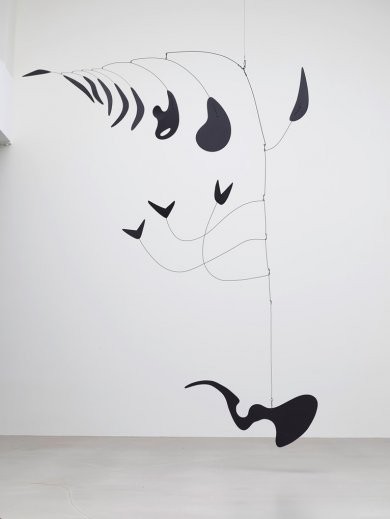Calder and Abstraction: From Avant-Garde to Iconic
24 Nov 2013 - 27 Jul 2014

Alexander Calder
Eucalyptus, 1940
sheet metal, wire, and paint
94 1/2 x 61 inches
Calder Foundation, New York; Gift of Andréa Davidson, Shawn Davidson, Alexander S.C. Rower, & Holton Rower, 2010. © 2013 Calder Foundation, New York / Artists Rights Society (ARS), New York, photo courtesy Calder Foundation, New York/Art Resource, NY.
Eucalyptus, 1940
sheet metal, wire, and paint
94 1/2 x 61 inches
Calder Foundation, New York; Gift of Andréa Davidson, Shawn Davidson, Alexander S.C. Rower, & Holton Rower, 2010. © 2013 Calder Foundation, New York / Artists Rights Society (ARS), New York, photo courtesy Calder Foundation, New York/Art Resource, NY.
CALDER AND ABSTRACTION: FROM AVANT-GARDE TO ICONIC
24 November 2013 – 27 July 2014
One of the most important artists of the twentieth century, Alexander Calder revolutionized modern sculpture. Calder and Abstraction: From Avant-Garde to Iconic, with significant cooperation from the Calder Foundation, explores the artist’s radical translation of French Surrealist vocabulary into American vernacular. His most iconic works, coined mobiles by Marcel Duchamp, are kinetic sculptures in which flat pieces of painted metal connected by wire move delicately in the air, propelled by motors or air currents. His later stabiles are monumental structures, whose arching forms and massive steel planes continue his engagement with dynamism and daring innovation. Although this will be his first museum exhibition in Los Angeles, Calder holds a significant place in LACMA’s history: the museum commissioned Three Quintains (Hello Girls) for its opening in 1965. The installation was designed by architect Frank O. Gehry.
Calder and Abstraction: From Avant-Garde to Iconic was organized by the Los Angeles County Museum of Art, in cooperation with the Calder Foundation, New York. Funding provided by LACMA's Art Museum Council and Phillips. This exhibition is supported by an indemnity from the Federal Council on the Arts and the Humanities.
24 November 2013 – 27 July 2014
One of the most important artists of the twentieth century, Alexander Calder revolutionized modern sculpture. Calder and Abstraction: From Avant-Garde to Iconic, with significant cooperation from the Calder Foundation, explores the artist’s radical translation of French Surrealist vocabulary into American vernacular. His most iconic works, coined mobiles by Marcel Duchamp, are kinetic sculptures in which flat pieces of painted metal connected by wire move delicately in the air, propelled by motors or air currents. His later stabiles are monumental structures, whose arching forms and massive steel planes continue his engagement with dynamism and daring innovation. Although this will be his first museum exhibition in Los Angeles, Calder holds a significant place in LACMA’s history: the museum commissioned Three Quintains (Hello Girls) for its opening in 1965. The installation was designed by architect Frank O. Gehry.
Calder and Abstraction: From Avant-Garde to Iconic was organized by the Los Angeles County Museum of Art, in cooperation with the Calder Foundation, New York. Funding provided by LACMA's Art Museum Council and Phillips. This exhibition is supported by an indemnity from the Federal Council on the Arts and the Humanities.
